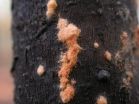(Press-News.org) Numerous nanomaterials are currently at the focus of public attention. In particular silver nanoparticles are being investigated in detail, both by scientists as well as by the regulatory authorities. The assumption behind this interest is that they are dealing with a completely new substance. However, Empa researchers Bernd Nowack and Harald Krug, together with Murray Heights of the company HeiQ have shown in a paper recently published in the journal Environmental Science & Technology that nanosilver is by no means the discovery of the 21st century. Silver particles with diameters of seven to nine nm were mentioned as early as 1889. They were used in medications or as biocides to prevent the growth of bacteria on surfaces, for example in antibacterial water filters or in algaecides for swimming pools.
The material has always been the same
The nanoparticles were known as "colloidal silver" in those days, but what was meant was the same then as now – extremely small particles of silver. The only new aspect is the use today of the prefix "nano". "However," according to Bernd Nowack, "nano does not mean something new, and nor does it mean something that is harmful." When "colloidal silver" became available on the market in large quantities in the 1920s it was the topic of numerous studies and subject to appropriate regulation by the authorities. Even in those days the significance of the discovery of nanoparticles and how they worked was realized. "That is not to say that the possible side-effects of nanoparticles on humans and the environment should be played down or ignored," adds Nowack. It is important to characterize in exact detail the material properties of nanosilver and not just to believe unquestioningly the doubts and reservations surrounding the product.
Nanosilver has different effects than silver
The term nanoparticle is understood to refer to particles whose dimensions are less than 100 nm. Because of their minute size nanoparticles have different properties than those of larger particles of the same material. For example, for a given volume nanoparticles have a much greater surface area, so they are frequently much more reactive than the bulk material. In addition, even in small quantities nanosilver produces more silver ions than solid silver. These silver ions are toxic to bacteria. Whether or not nanosilver represents a risk to humans and the environment is currently the subject of a great deal of investigation.
Literature
120 Years of Nanosilver History: Implications for Policy Makers, Bernd Nowack, Harald F. Krug, Murray Height, Environ Sci Technol, 2011, DOI: 10.1021/es103316q
Nanosilver in wastewater treatment plants
Currently there are hundreds of products in circulation which contain silver nanoparticles. Examples include cosmetics, food packaging materials, disinfectants, cleaning agents and – not least – antibacterial socks and underwear. Every year some 320 tonnes of nanosilver are used worldwide, some of which is released into wastewater, thus finding its way into natural water recirculation systems. What effects solar particles have on rivers, soil and the organisms that live in them has not yet been clarified in detail. A commentary by Bernd Nowack in the scientific journal Science discusses the implications of the newest studies on nanosilver in sewage treatment plants. More than 90% remains bound in the sewage sludge in the form of silver sulfide, a substance which is extremely insoluble and orders of magnitude less poisonous than free silver ions. It apparently does not matter what the original form of the silver in the wastewater was, whether as metallic nanoparticles, as silver ions in solution or as precipitated insoluble silver salts. "As far as the environmental effects are concerned, it seems that nanosilver in consumer goods is no different than other forms of silver and represents only a minor problem for eco-systems," says Nowack. What is still to be clarified, however, is in what form the unbound silver is present in the treated water released from sewage works, and what happens to the silver sulfide in natural waters. Is this stable and unreactive or is it transformed into other forms of silver?
INFORMATION:
Nanosilver Revisited Downstream, Bernd Nowack, Science, 2010, Vol. 330 no. 6007, pp. 1054-1055, DOI: 10.1126/science.1198074
END
Offering the morning after pill free over the counter has not reduced the number of teenage pregnancies and may be associated with a rise in sexually-transmitted diseases (STIs), according to a report by experts at The University of Nottingham.
Professors David Paton and Sourafel Girma used local health authority data to study the impact that the introduction of Government-backed schemes to offer emergency birth control at pharmacies and without prescription have had on conception rates and the diagnosis of STIs among under-18s.
Their findings show that, on average, ...
Geneva, 31 January 2011. CERN today announced that the LHC will run through to the end of 2012 with a short technical stop at the end of 2011. The beam energy for 2011 will be 3.5 TeV. This decision, taken by CERN management following the annual planning workshop held in Chamonix last week and a report delivered today by the laboratory's machine advisory committee, gives the LHC's experiments a good chance of finding new physics in the next two years, before the LHC goes into a long shutdown to prepare for higher energy running starting 2014.
"If LHC continues to improve ...
Chestnut Hill, Mass. (1/31/2011) – Red Bull's red and gold logo can "give you wings" – for better or worse – even if consumers don't know it, according to a new study by two Boston College professors, who found the brand's edgy marketing efforts have sold a heavy dose of attitude to consumers.
Researchers put subjects at the controls of a car racing video game, supplying each with functionally identical racecars, but each car decorated with a different brand logo and color scheme.
Players put in control of the Red Bull car displayed the characteristics often attributed ...
The more we learn about biology, the closer we get to being able to treat disease – and the more complicated our understanding of disease itself becomes.
A new research finding showing a strong relationship between complex microbial ecologies in human intestines and the common but serious medical condition known as fatty liver illustrates this paradox.
From past genomic studies, we have learned that a mind-boggling multitude of different kinds of benign bacteria inhabit our intestines and that these populations can vary almost infinitely from one human being to the ...
Boston, MA—Scientists have found that free radicals (unstable molecules that cause the death of cells as the body ages) may also cause the damage in the eyes of patients with Fuchs Endothelial Corneal Dystrophy (FECD), a hereditary disease that is one of the most common reasons for corneal transplants worldwide.
The finding, published in the November 2010 American Journal of Pathology, holds promise for early and preventative treatments for this disease, which impacts nearly four percent of the population over age 60.
"Our discovery is significant, because it gives ...
Berkeley – In a demonstration of "reverse-ecology," biologists at the University of California, Berkeley, have shown that one can determine an organism's adaptive traits by looking first at its genome and checking for variations across a population.
The study, to be published the week of Jan. 31 in the journal Proceedings of the National Academy of Sciences, offers a powerful new tool in evolutionary genetics research, one that could be used to help monitor the effects of climate change and habitat destruction.
The researchers scanned the genes of 48 different strains ...
The scientists have now carried out the first full run of experiments that smash protons together at almost the speed of light. When these sub-atomic particles collide at the heart of the CMS detector, the resultant energies and densities are similar to those that were present in the first instants of the Universe, immediately after the Big Bang some 13.7 billion years ago. The unique conditions created by these collisions can lead to the production of new particles that would have existed in those early instants and have since disappeared.
The researchers say they are ...
New Haven, Conn.—A team of Yale University scientists has synthesized for the first time a chemical compound called lomaiviticin aglycon, leading to the development of a new class of molecules that appear to target and destroy cancer stem cells.
Chemists worldwide have been interested in lomaiviticin's potential anticancer properties since its discovery in 2001. But so far, they have been unable to obtain significant quantities of the compound, which is produced by a rare marine bacterium that cannot be easily coaxed into creating the molecule. For the past decade, different ...
Researchers at National Jewish Health have discovered a signaling pathway that is crucial to the devastating effects of acute lung injury (ALI). The data, obtained from cells, animals and ALI patients, suggest several potential therapeutic targets. Experimental blockade of one of the targets significantly reduced flooding of the lungs that is the hallmark of ALI.
"Acute lung injury is a devastating disease, with 40 percent mortality and no beneficial therapies," said first author James Finigan, MD, Assistant Professor of Medicine at National Jewish Health. "Our study ...
It takes songbirds and baseball pitchers thousands of repetitions – a choreography of many muscle movements -- to develop an irresistible trill or a killer slider. Now, scientists have discovered that the male Bengalese finch uses a simple mental computation and an uncanny memory to create its near-perfect mate-catching melody -- a finding that could have implications for rehabilitating people with neuromuscular diseases and injuries.
Young male Bengalese finches practice their boisterous mating song hundreds of times a day, comparing their melody to the songs of their ...

